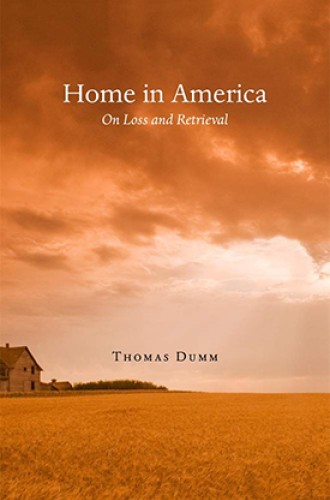American homes are haunted, Thomas Dumm argues, and so is the American concept of home: it was created by immigrants who took land from the inhabitants and enslaved others in the name of their own freedom. This set of contradictions gives “home in America” a peculiarly fraught character.
Among the houses Dumm considers key to America’s development are Thomas Jefferson’s Monticello, Henry David Thoreau’s cabin at Walden Pond, Laura Ingalls Wilder’s little houses, Emily Dickinson’s house of poetry, and Herman Wallace’s dream house sketched from the confines of the Louisiana State Penitentiary. Dumm weaves this combination of textual and physical houses into a unique meditation on the means and uses of freedom in American history.
Jefferson’s Monticello is often considered to have been built as a monument to democracy. The white, landholding man in America was free in a way that few others had been throughout the history of the world. But Dumm demonstrates how Jefferson’s attempt to create this monument enslaved others and himself on multiple levels.
Jefferson had to maximize the labor of others to ensure his own freedom—and still he failed at it. He lived his life deeply in debt, scared of creditors, and dedicated to creating an image of prosperity that was largely false. “He was constantly on the verge of bankruptcy but was able to keep the appearance of grand riches throughout his life, a benevolent statesman and gracious host.” Keeping up appearances included hiding his relationship with Sally Hemings, whom he enslaved along with the children born to him and Hemings.
Even Jefferson’s nonslave children were subjected to his power and control in extreme fashion. In a letter to one of his white daughters, he insisted that she should live as if he were always watching her. Surveillance was a critical aspect of life at Monticello, and Jefferson drew many of his ideas from the prison reform efforts being made by his friend Jeremy Bentham. In other words, Monticello was “a great exception to the public freedoms that democrats would espouse in ending the tyrannies of the British over Americans.” These embedded contradictions make Monticello a truly representative American home.
Thoreau knew that making a home in America could drive a person into debt. He wrote that he saw his neighbors laboring “under a false necessity,” and he was determined to find another way. He might have been thinking of Jefferson when he wrote, “It is hard to have a southern overseer; it is worse to have a northern one; but worst of all when you are the slave-driver of yourself.” Thoreau, who radically opposed slavery, believed that plantation owners were caught in webs of their own design.
In order to create freedom, Thoreau decided to “swap possessions for time.” He famously went to the woods to learn “to live deliberately,” and Dumm makes a great deal of this word. In ancient Rome, Liber was the god of fertility, wine, and freedom, also known as “the free one.” To deliberate is to engage in an intentional process of determining the nature of one’s own freedom. But liber is also Latin for “book.” Thoreau connects these two senses of liber, using writing both to create and to account for his own freedom.
Thoreau didn’t go to the woods simply to live; he went to the woods to write. By writing, he made a private freedom public. His main objective, says Dumm, was to demonstrate a method by which all might be free. “Thoreau’s democratic turn is to urge us all to think, to think for ourselves, yes, to trust ourselves . . . as fully realized, robustly acting human beings.” This is what it means in Thoreauvian terms to build our houses deliberately.
Laura Ingalls Wilder’s family went deep into unknown territory to make a bid for American freedom. As they tried to make a home on the edge of their known world, Ma Ingalls displayed a reflexive hatred toward those who’d inhabited the land before them. “Why don’t you like Indians, Ma?” little Laura asks in Little House on the Prairie. “I just don’t like them,” Ma answers.
The family moved frequently, chased by political winds and environmental disasters created by the settlers themselves. Even so, they preached a particular mode of civilization that they believed must come to dominate the land, whatever the cost. Wilder’s story is, in Dumm’s terms, a “cautionary tale, an American nightmare from which we have not yet, even now, awoken.”
Emily Dickinson rarely left her father’s house on the edge of Amherst, Massachusetts. Within his house, however, she created another house—a house of poetry.
I dwell in Possibility—
A fairer House than Prose—
More numerous of Windows—
Superior—for Doors—
Like Thoreau, Dickinson built her house and her freedom out of words. She transcended convention so she could sit in a position to “Look down upon Captivity.”
But unlike Thoreau, Dickinson’s bid for freedom was largely a private one. Her captivity was a product of gender, social class, and perhaps illness, but she also chose to create a zone of nearly absolute privacy around her poetry, so that only at her death were its dimensions discovered.
Dickinson’s evocation of captivity—an important ghost in all of these houses—moves Dumm to consider Herman Wallace, an incarcerated man who died in 2013, three days after being released from the prison where he spent nearly four decades of his life. A member of the Black Panthers, Wallace was initially imprisoned for armed robbery and then accused along with two others of killing a prison guard. He spent most of his years in prison in solitary confinement.
An artist named Jackie Sumell struck up a correspondence with Wallace, and eventually she asked him a transformative question: “What kind of a house does a man who has lived his life in a six-foot-by-nine-foot cell for over 30 years dream of?” Together the two of them began to build Wallace’s dream house. It was a construct first and foremost of Wallace’s imagination, although it began to take on physical dimensions when Sumell made it into a scale model art installation.
Home in America is a strange ride through American history and culture, but one worth taking. Dumm’s reflections on his own home and homemaking may inspire us all to see our own houses in a new light.






